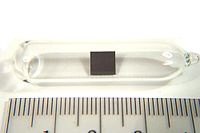
Photo from wikipedia
Owing to their natural radioactivity, uranium (U) and thorium (Th) play significant roles in environmental sciences for monitoring radiation dose and in geological sciences for understanding sedimentary processes. The Odisha… Click to show full abstract
Owing to their natural radioactivity, uranium (U) and thorium (Th) play significant roles in environmental sciences for monitoring radiation dose and in geological sciences for understanding sedimentary processes. The Odisha coastal area, in eastern India, is a well-known high background radiation area that is rich in monazites and rutile. This area was selected to study geochemical characteristics of U and Th in sand and sandy soil samples. The concentrations of U and Th were measured using inductively coupled plasma mass spectrometry (ICP-MS). The median, geometric mean, and standard deviation for U were determined to be 6, 4.5, and 2.5 μg/g and for Th were 186, 123.3, and 3.1 μg/g, respectively. Major element concentrations were evaluated using X-ray fluorescence spectroscopy to get the mineralogical composition and state of chemical weathering. The ratios of Th/U and Th/K varied from 4 to 37 and from 13 to 1058, respectively. These results clearly indicate that the samples from the coastal region were formed in an oxidizing and intense chemical weathering terrestrial environment with an enrichment of radiogenic heavy minerals (monazites and zircon) and clay mineral association. Since the majority of the samples have undergone moderate to intense weathering in the oxidizing environment, U is leached from the soil and sand matrix. Eventually, Th resides in the matrix and becomes a major source for radiation exposure in the environment. The high ratios of Th/U, along with the strong positive correlation between Th and P 2 O 5 , evidence the enrichment of the Th-bearing radioactive mineral, monazite, in these samples.
Journal Title: Environmental Science and Pollution Research
Year Published: 2020
Link to full text (if available)
Share on Social Media: Sign Up to like & get
recommendations!